How is boric acid spraying useful for tomatoes?
Boric acid is successfully used in medicine to treat various diseases. But this is not the only industry that uses this tool. Boric acid is also used when growing vegetables. Its solution is widely used by summer residents as an effective fertilizer for tomatoes. Do you want to know all the secrets of feeding tomatoes with boric acid? Then this article is for you.
The content of the article
What boric acid gives to tomatoes
Many gardeners note that tomatoes respond well to fertilizers, responding to care with good fruiting. One of the best food for tomatoes is boric acid. It is experimentally calculated that the yield of tomatoes when fertilized with boron increases by 20-30%. This is achieved by increasing flowering and increasing the number of ovaries on tomato bushes.
Boric acid not only saturates plants with an important trace element - boron, but is also considered a strong remedy for phytophthora.
Thanks to boron, the sugar content of tomatoes increases and their keeping quality improves.
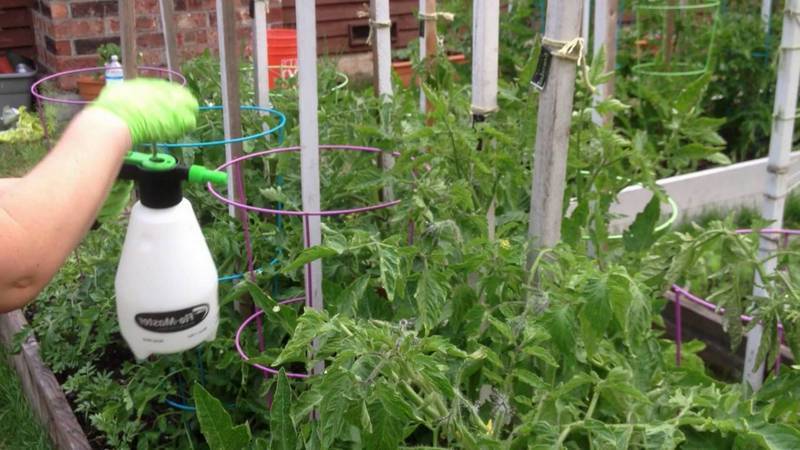
Signs of a boron deficiency in a tomato
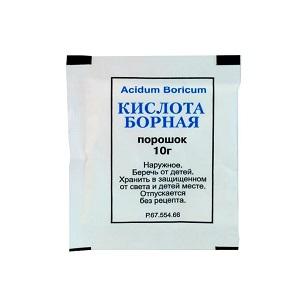 Boron, as a trace element, is necessary for tomatoes:
Boron, as a trace element, is necessary for tomatoes:
- to enhance the absorption of calcium;
- increased root respiration;
- synthesis of biologically active substances.
If the plants do not have enough boron, this immediately affects the appearance:
- the top of the plant begins to dry (it may dry out altogether, but the growth of lateral shoots does not stop);
- flowers fall off the plant;
- the fruits are covered with dry spots;
- leaves curl and change color (brighten).
How to prepare a nutrient solution
You can feed tomatoes using other components useful for tomatoes in combination with boron:
- iodine;
- potassium permanganate;
- milk;
- ash, etc.
Consider the best recipes for preparing a boric acid solution for feeding tomatoes.
Milk whey with iodine and boron
Milk-whey solution applied to tomato leaves forms a film on the surface that prevents the development of diseases (including late blight). To increase the effect of spraying, boron and iodine are added to the solution. The composition is also suitable for root dressing.
How to water tomatoes with iodine and milk using boric acid? It must be dissolved in 0.5 cups of hot water 0.5 tsp. boric acid (no slide).
When cool, mix with the following ingredients:
- 1 liter of whey (sour milk is suitable for replacement);
- 20 drops of iodine;
- 4 liters of water.
This solution can be used to feed tomatoes growing as in greenhouseand in the open soil... When watering, the solution consumption is 0.5 liters per bush.
Attention! Before applying fertilizers at the root, it is advisable to water the tomato bush with plain water.
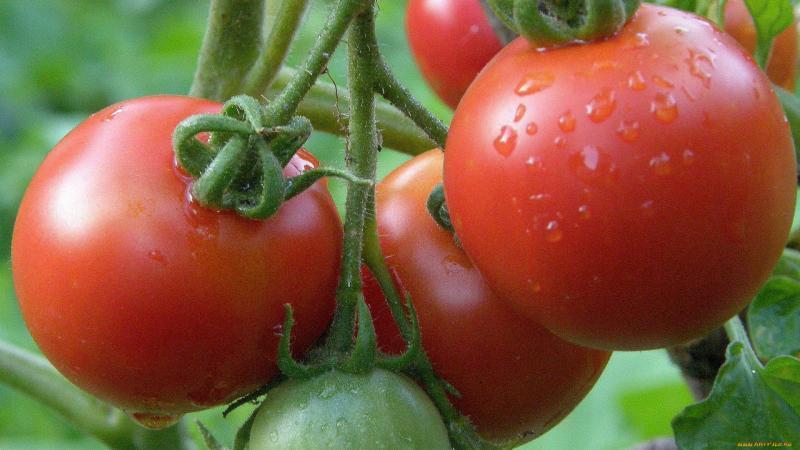
Ash with iodine and boron
Tomatoes are very fond of boric iodine cocktail with ash. It is prepared using stove ash or wood ash. In 10 liters of water, boil 2 liters of ash. After the mixture has cooled to 60-70 degrees, 1 tsp is dissolved in it. boric acid powder.
Then add 30 drops of iodine. The composition is suitable both for fertilizing plants at the root - 0.5 liters per bush, and for irrigation on leaves - by abundant spraying from a spray bottle. According to reviews, the best results bring foliar top dressing.
Potassium permanganate with iodine and boron
Many experienced gardeners prefer this particular feeding method. It gives both disinfection, and increased productivity, and protection against late blight.
Potassium permanganate (potassium permanganate) is an effective antiseptic capable of disinfecting both the plant and the soil in which it grows. Its effect on tomatoes is manifested by strengthening the tops and disinfecting the entire plant. This is especially important for the restoration of a tomato bush after pinching. Consider how to process tomatoes with boric acid, potassium permanganate and iodine tincture.
Experienced tomato growers advise feeding in 3 stages (with a break of 5-7 days):
- Processing tomato bushes with manganese solution. 4-5 g of manganese is diluted in 10 liters of water. Tomatoes are sprayed with a solution or watered under the root at the rate of 0.5 liters per bush.
- Spraying with boron. For 10 liters of water, dilute 0.5-1 tsp. powder and process the aerial part of the plants from a spray bottle.
- Iodine top dressing. Processing is carried out on sheets. The solution is prepared from 10 drops of iodine in 5 liters of water. Treatment with the resulting composition of tomato leaves is comparable in effect to nitrogen fertilization (for example, saltpeter or urea).
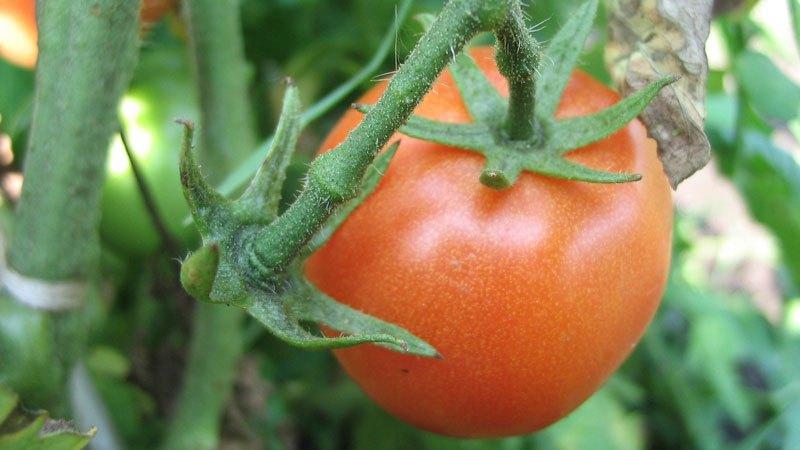
Metronidazole with iodine and boric acid
Metronidazole tablets can be purchased at the pharmacy. Their antibacterial properties are successfully used in medicine. According to the manufacturer's instructions, the drug inhibits the development of protozoa and some other microorganisms. On tomatoes, it effectively fights against late blight.
The use of "Metronidazole" gives good results in combination with iodine and boron. Recipe: 20 tablets of "Metronidazole" are pounded into powder and dissolved in 10 liters of water, adding 20 drops of iodine and 0.5 tsp. boric acid powder (boron is preliminarily diluted in hot water). The liquid is used to spray tomatoes.
Note. To enhance protection against late blight, 5 g of brilliant green can be added to the solution.
How often should fertilizing and spraying be carried out
It is very important to use boron correctly. It is advisable to do 3 top dressing during the season (this can be both sub-root applications and spraying on the leaves):
- Before flowering tomatoes - during the growth of the green mass of the bush.
- During flowering.
- When setting fruit.
Reference. Most gardeners prefer to fertilize tomatoes using boron in the foliar way.
Do not feed tomatoes with boric acid more than 3 times per season. An excess of boron can negatively affect the condition of plants. For example, from the "extra" boron on the leaves, dry spots may appear or the tops of the plant twist. If you allow an overdose of spraying during flowering tomatoes, then the pollen on the plants can burn out, and there will be no ovaries.
Important! It is advisable to take a break between any feeding of tomatoes at least 10-12 days. This will help avoid unpleasant consequences.
Important rules
Many tomato growers (both beginners and experienced) often make mistakes when using dressings with boric acid. They can be avoided if you remember the basic rules for feeding tomatoes with boron:
- the water temperature for dissolving crystals should be 50-70 degrees. Boric acid will not dissolve in colder water. The aboveground part of the plants can get burned;
- do not prepare the solution in advance. It is better to do this immediately before use, since the usefulness of the solution decreases during storage;
- it is better to do foliar feeding with boron in dry, calm weather. Moreover, in the evening. This will ensure efficiency and eliminate the risk of sunburn on wet leaves;
- for foliar processing, the leaves are sprayed on both sides. Spraying the solution from a spray bottle is done so that a drizzle forms near the bush. It is advisable not to allow visible drops on the leaves when processing.
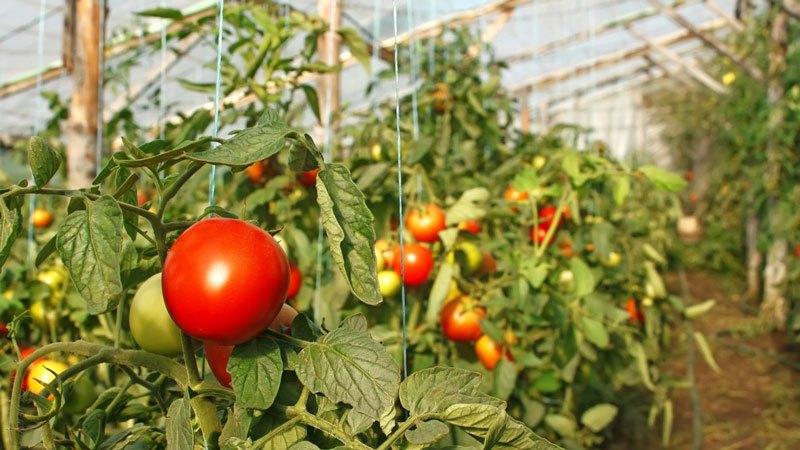
Let's sum up
Boric acid is a unique agent for increasing the yield of tomatoes. Spraying the bushes with its solution helps to effectively fight late blight.
There are many recipes for boron feeding. According to tomato growers, the best yields are obtained by spraying tomatoes with milk with iodine, boric acid and potassium permanganate.It is important to observe the mixing proportions of the components so that the tomato bushes do not get burned. If you follow all the rules, tomatoes will be reliably protected from late blight and will delight you with a good harvest.